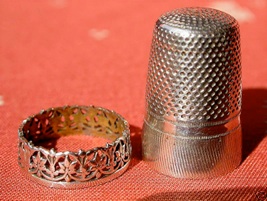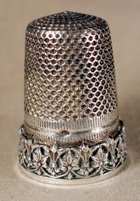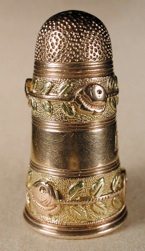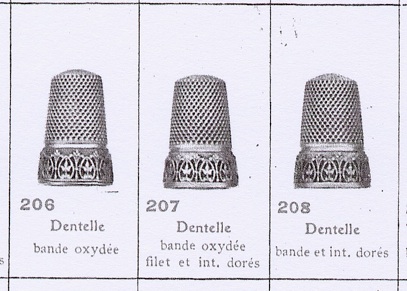More about Thimbles





Magdalena and William Isbister.
We were surprised, recently, to see a ‘rare antique French wedding ring thimble‘ listed on Ebay. We started to wonder about wedding ring thimbles in general and this ‘rare’ French one in particular.


The Ebay thimble A. Féau thimble 1910.
The first reference to a ‘wedding band’ that we were able to find was made, in 1983, by Dreesmann (1) who mentions a ‘so called wedding band motif’ but does not state in her book whether the ‘band’ comes off. Does her description, however, indicate a degree of scepticism?
In 1985, Zalkin (2) described an 18th century tall gold French ‘wedding band’ thimble with two garlands. She said that ‘one garland can be removed to make a wedding band’. There is no image in her book to show the band removed. We have seen several of these tall French thimbles with single or double applied gold floral bands but none were removable! Have we just not seen the correct thimble or was Zalkin simply following Dreesmann?

French 18th century ‘wedding band’ type
We have not been able to find any other references to ‘wedding band’ thimbles in the thimble literature although love tokens and rings have been in use for centuries.
We approached the question from another angle. Sewing and ‘keepsake’ thimbles were sized to fit the terminal phalanx of the sewing finger. In the 18th and early 19th centuries it seems that finger sizes were smaller than they are today as evidenced by the small diameters of thimbles from this period. If a ‘wedding band’ were applied loosely, mid way up a thimble of the period it is highly unlikely that the band would fit over the smallest finger joint far less fit the base of the wedding finger. These so called applied ‘wedding bands’, even if some came off the thimble, could thus never have been worn because they would not have fitted!
Turning now to the thimble listed on Ebay. It was claimed that it was ‘a rare antique silver thimble because it once was a gift of love. The border of the thimble is actually a ring and when a lady accepted a thimble like this, she accepted the love of the one who presented it to her.’ The next statement reinforces the argument made above about size. ‘It is a small thimble, the ring doesn't even fit my little finger’. Examination of pictures of the ‘ring’ shows that the top edge has many sharp spikes, and the bottom is quite sharp. It would not be the sort of thing that one would give to a loved one to wear! It would be too uncomfortable; it would also be too small with a diameter of 15 mm. Further evidence that this ring is simply an applied band that has come loose comes from an A Féau catalogue, from the early 20th century, where a very similar thimble is illustrated – number 207 ‘Dentelle’. ‘band oxydée filet et int. dorés’. The thimble is also illustrated in ‘La folie des Des a Coudre’ (3) and again there is no evidence of a detachable ring.

‘Dentelle’ style – A. Féau catalogue
We have been unable to obtain any evidence for the existence of a ‘wedding band’ thimble and certainly the thimble listed on Ebay has simply come unsoldered. We think it is time to set aside the myth of the ‘wedding band’ thimble.
References
1. Dreesmann C. A thimble full.… Utrecht/Netherlands: Cambium, 1983. pp. 36-7.
2. Zalkin E. Zalkin’s Handbook of Thimbles & Sewing Implements, 1st edn. Willow Grove: Warman Publishing Co., Inc., 1985. plate 6.
-
3.Crestin-Billet F. La folie des Des a Coudre. Paris: Flammarion, 2003. pp. 241.
Holmes: ‘Thimbles in France’ pp. 65.
Researched and published in 2002/11
Copyright@2011. All Rights Reserved
Magdalena and William Isbister, Moosbach, Germany
the ‘wedding’ thimble
Navigation
